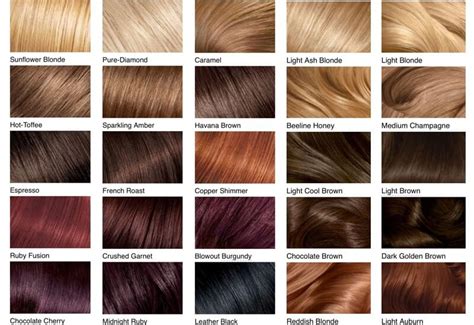Introduction
Hair plays a crucial role in defining our physical appearance and self-expression. The right hair color can enhance our features, boost our confidence, and make us feel fabulous. With so many hair color options available today, finding the best one for you can be overwhelming. This comprehensive guide will provide you with everything you need to know to choose and achieve the perfect hair color for your individual style and needs.

10 Key Factors to Consider
When selecting a hair color, it’s essential to consider the following factors:
- Skin Tone: Warm skin tones complement golden, copper, and auburn hues, while cool skin tones look best with ash, blue, or violet shades.
- Eye Color: Blue eyes are enhanced by warm shades like copper and golden blonde, while brown eyes look stunning with rich chocolates and caramels.
- Hair Texture: Fine hair can handle lighter shades, while thick hair can support darker colors without overwhelming the features.
- Lifestyle: Frequent swimmers should consider chlorine-resistant colors, while those exposed to the sun may need to opt for fade-resistant shades.
- Personal Style: Bold and adventurous individuals may prefer vibrant colors, while those seeking a more natural look can stick with subtle shades.
- Maintenance: Some colors require regular touch-ups, while others are relatively low-maintenance. Determine how much time and effort you’re willing to invest in upkeep.
- Hair Health: Consider your hair’s condition before coloring. Damaged hair may require specialized care to prevent further breakage.
- Professional vs. DIY: Home hair color kits are convenient but may not provide the same results as a professional salon.
- Cost: The cost of hair coloring can vary depending on the technique, color, and salon.
- Personal Taste: Ultimately, the best hair color is the one that makes you feel confident and beautiful. Embrace your individuality and experiment until you find the perfect shade for you.
Hair Color Trends for 2023
Stay ahead of the curve with these hair color trends for 2023:
- Mushroom Blonde: This soft, ashy blonde shade flatters all skin tones and creates a natural, ethereal look.
- Copper Crush: Warm and inviting, copper is a bold choice for those seeking to add depth and warmth to their hair.
- Golden Caramel: A blend of warm blonde and deep caramel, this shade adds richness and shine to hair while enhancing skin tone.
- Silky Brunette: Embrace the beauty of natural hair with a rich, chocolatey brunette shade that complements both warm and cool skin tones.
- Icy Lavender: For those seeking a unique and edgy look, icy lavender adds a touch of whimsy to any hair color.
Expert Tips for Choosing the Right Hair Color
Consult a Professional: Schedule an appointment with a colorist to discuss your desired look and concerns. They can assess your hair health, suggest suitable shades, and provide expert advice.
Research Color Swatches: Gather images of various hair colors that appeal to you. Experiment with virtual hair color apps to see how different shades would look on your hair.
Test a Strand: Before committing to a full head of color, apply a small amount of dye to a strand of hair to test the results. This allows you to adjust the color or developer strength if necessary.
Consider Root Blending: If you’re sticking close to your natural color, consider root blending to create a more seamless transition from your roots to the colored hair.
Be Realistic: Don’t attempt to achieve a hair color that is drastically different from your natural shade. Gradual changes are often more flattering and easier to maintain.
Step-by-Step Guide to Coloring Your Hair
Materials:
- Hair dye
- Developer
- Applicator brush
- Hair clips
- Gloves
- Towel
Instructions:
- Prepare Your Hair: Wash and towel-dry your hair. Apply a pre-shampoo treatment or color-protecting spray to protect your hair from damage.
- Section Your Hair: Divide your hair into sections using hair clips to make the application easier.
- Mix the Dye: Follow the manufacturer’s instructions to mix the hair dye and developer in a bowl.
- Apply the Dye: Using an applicator brush, apply the dye to your hair in sections, starting at the roots.
- Develop: Allow the dye to develop for the specified time, as indicated on the manufacturer’s instructions.
- Rinse and Condition: Rinse your hair thoroughly with lukewarm water to remove the dye. Apply a deep conditioner to nourish and moisturize your hair.
- Style: Blow-dry and style your hair as usual.
Common Mistakes to Avoid
- Over-Processing: Leaving the dye on for too long can damage your hair and cause breakage.
- Uneven Application: Applying the dye unevenly can result in patches of different colors.
- Incorrect Developer Strength: Using developer that is too strong or too weak can affect the color results.
- Coloring Damaged Hair: Coloring hair that is already damaged can worsen the condition and cause further breakage.
- Not Following Instructions: Ignoring manufacturer’s instructions can result in unexpected color outcomes.
Innovative Hair Color Applications
Ombré: A gradual transition from one color to another, ombré creates a sophisticated and sun-kissed effect.
Balayage: Freehand hair painting that adds subtle highlights and creates a natural, lived-in look.
Sombre: A softer variation of ombré, sombre features a subtle blend of colors that adds depth and dimension to hair.
Babylights: Tiny, delicate highlights that mimic the natural strands of hair, adding warmth and brightness to the overall color.
Conclusion
Finding the best hair color for you is a personal journey that involves consideration of multiple factors, including skin tone, eye color, hair texture, and personal style. By following the expert tips and step-by-step instructions provided in this guide, you can achieve the perfect hair color that enhances your features, boosts your confidence, and makes you feel fabulous. Remember, the best hair color is the one that makes you feel beautiful and confident. So, embrace your individuality and experiment until you find the perfect shade for you.
